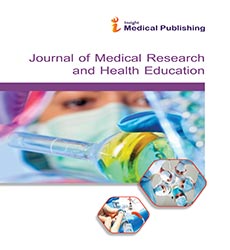Formation of Acne and its Medical Treatment
Nicolea Brokmen*
Departmennt of Biology and Biochemistry, Northern Ontario School of Medicine, Canada
- *Corresponding Author:
Received date: July 07, 2021; Accepted date: July 21, 2021; Published date: July 28, 2021
Citation: Nicolea Brokmen (2021) Formation of Acne and its Medical Treatment. J Med Res Health Educ Vol. 5 No. 4: 003
Commentary
Acne vulgaris is a common chronic skin disease, caused by the blockage and inflammation of hair follicles and sebaceous glands. The uncontrolled production of sebum due to hormonal imbalance coupled with excessive shedding of dead skin cells, plugs the hair follicles. This phenomenon makes inflammation of the hair follicle and attracts more bacterial growth.
Acne mostly occurs on the areas where sebaceous glands are located that includes face, neck, chin, chest and back. Acne occurs in the form of blackheads, whiteheads, papules, pustules and nodules.
Whiteheads (closed comedones) are the enclosed follicular plugs beneath the skin surface while blackheads (open comedones) are the follicular plugs that are oxidized by getting exposed to air and turn black colour. Papules are small red bumps formed when the excess sebum comes in contact with the bacteria on the skin. The papules eventually get filled with pus and become pustules. Nodules are formed when the acne causing bacteria are trapped inside a clogged pore and infect the deeper layers of the skin.
Touching the acne and popping up the pustules makes the infection worse and leads to the formation of scars on the skin. There are lot of treatments available for clearing acne. First line of treatment for blackheads and whiteheads involves applying salicylic acid based ointments and creams such as salicure, which penetrates deep into the skin to unplug the pores and dissolves the dead skin cells and makes the pimples to shrink. Benzoyl peroxide based ointments and gels are used for treating pustules by removing excess sebum and dead skin cells.
After the pores shrink acne scars are formed. Chemical peel treatment is applied to remove dark spots. Dermatologists may come up with a tailored treatment plan for acne scars for each unique individual. Acne scar surgery for treating a few depressed scars. Resurfacing procedures for not shallow depressed acne scars. Fillers is used for treating a few depressed scars, but not icepick scars. Skin tightening is applied for depressed acne scars and this type of treatment is safe for all skin colours. Sometimes, skin tightening effectively treats deep icepick and boxcar scars. Collagen induction therapy is used for for widespread depressed acne scars. Electrodesiccation treatment uses electric probes for shaping or reducing the edges of boxcar scars. Injections are used for Painful, raised scars. Acne scar surgery, followed by injections and Acne scar surgery, followed by radiation are used for raised scars that need stronger treatment than injections. Cryosurgery is used to effectively diminish raised scars in people with lighter skin tone. Scar creams, gels, and silicone dressings can be used at home to treat raised scars for reducing scar size and discomfort. Laser therapy is used for all types of acne scars. During the course of treatment sunscreen must be used to avoid sunburn and adverse reactions. Face washes with less concentration of salicylic acid and benzoyl peroxide should be used. Face washes containing harsh chemicals should be avoided on acne prone skin. During the course of treatment more consumption of citrus fruits and 8 glasses of water daily is advised.
To avoid acne in the first place, eating balanced diet and sufficient sleep is necessary for hormonal balance. Use of mild face washes and applying only oil free cosmetics controls excess sebum retention on the skin.
Open Access Journals
- Aquaculture & Veterinary Science
- Chemistry & Chemical Sciences
- Clinical Sciences
- Engineering
- General Science
- Genetics & Molecular Biology
- Health Care & Nursing
- Immunology & Microbiology
- Materials Science
- Mathematics & Physics
- Medical Sciences
- Neurology & Psychiatry
- Oncology & Cancer Science
- Pharmaceutical Sciences
